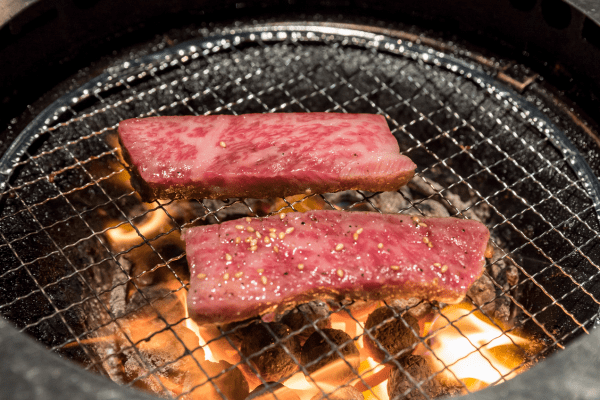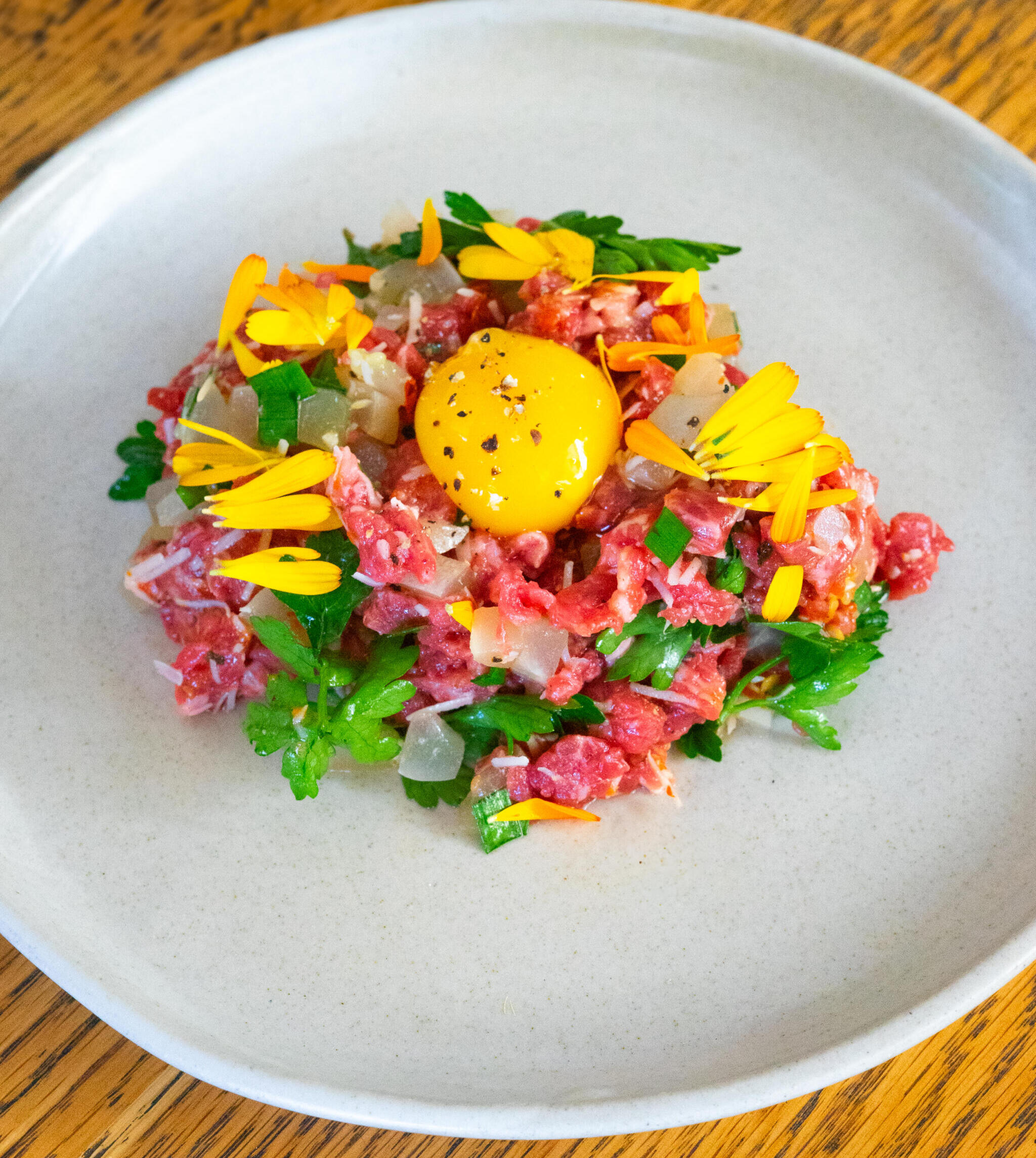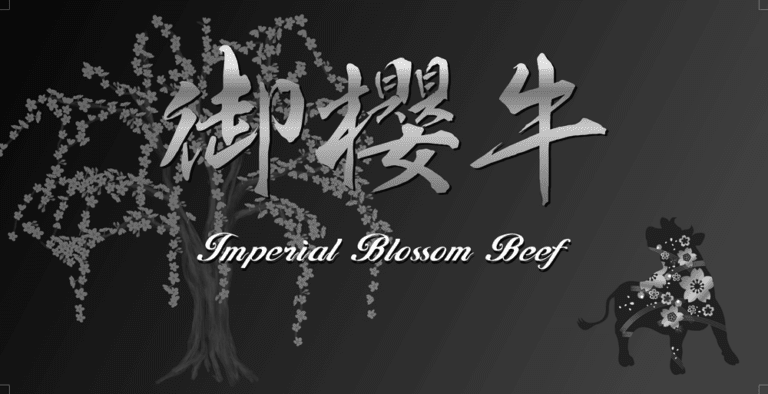
Grilled Stone Axe OP Rib, Seaweed Bearnaise, Coal Roasted Vegetables, Pepper Sauce (serves 2-4 pax)
Recipe by Shane Middleton, Head Chef of Papi Katsu Perth CBD Kombu -Jime +9 Stone Axe OP Rib 1 x

Wagyu beef, with its origins deeply rooted in Japan, has become a symbol of culinary excellence worldwide. Revered for its unparalleled marbling, tenderness, and luxurious flavour, Wagyu beef demands a level of culinary finesse to bring out its best qualities. At Lux Wagyu House, we prioritise nothing more than maintaining the quality of our Wagyu beef and equipping our customers with the essential knowledge needed to flawlessly cook the perfect cut of meat.
Wagyu beef possesses a rich, buttery flavour that should be celebrated rather than masked. Keep the seasoning simple to allow the natural taste to shine through. A light sprinkle of high-quality sea salt and freshly ground black pepper is often sufficient. For an added layer of flavour and to enhance the searing process, consider a light coating of olive oil.
Cooking Wagyu beef is an art that requires attention to detail, as different cuts demand distinct cooking techniques to maximise the flavours. Here, we’ll delve into the specific cooking methods for various cuts of Wagyu beef, emphasising the best practices to unlock their rich flavours and succulence.
Ribeye is a well-marbled cut, making it ideal for grilling. Preheat the grill to a high temperature and sear the ribeye on each side for a short duration to achieve a flavourful crust. The high fat content may cause flare-ups, so monitor the grill closely. Aim for a medium-rare to medium doneness to preserve the tenderness and rich marbling of the ribeye.
Alternatively, pan-searing is an excellent method for ribeye. Bring the meat to room temperature, season with salt and pepper, and sear in a hot skillet with a touch of oil. Add aromatics like rosemary and garlic to enhance the flavour. Finish the ribeye in the oven for even cooking and to ensure a golden crust on both sides.
Scotch Fillet, also known as Ribeye in some regions, is a prime cut renowned for its exceptional marbling and robust flavour. Grilling is a preferred method to bring out the best in this cut. Preheat the grill to medium-high heat, season the Scotch Fillet with salt and pepper, and grill each side for a few minutes. The high fat content ensures a delicious sear, and grilling imparts a smoky flavour. Aim for a medium-rare to medium doneness for the perfect balance of tenderness and taste.
Pan-searing is another fantastic technique for Scotch Fillet. Allow the meat to come to room temperature, season it with salt and pepper, and sear it in a hot skillet with a touch of oil. Add aromatic herbs like thyme or rosemary and finish the fillet in the oven for even cooking. This method creates a delightful crust while preserving the juiciness of the Wagyu beef.
For a more traditional approach, you can roast a Scotch Fillet in the oven. Season the meat generously, place it in a roasting pan, and roast at a moderate temperature. This method allows for even cooking, and the result is a tender and flavourful roast. Use a meat thermometer to monitor the internal temperature and allow the Scotch Fillet to rest before carving.
Reverse searing is a favoured method for cooking Tomahawk steaks to ensure an even cook and optimal tenderness. Start by seasoning the steak generously with salt and pepper. Then, slow-cook the Tomahawk in the oven at a low temperature until it reaches an internal temperature close to your desired doneness. Finish by searing the steak on a hot grill or in a cast-iron skillet to achieve a caramelised crust. This method allows for precise control over the cooking process and ensures a beautifully cooked Tomahawk.
Grilling is an excellent technique for a Tomahawk steak, showcasing the impressive bone and allowing for that distinctive smoky flavour. Preheat the grill to high heat. Sear the Tomahawk directly over the flames to create a flavourful crust, then move it to indirect heat to finish cooking. The bone acts as a natural insulator, contributing to a juicy and evenly cooked steak. Use a meat thermometer to monitor the internal temperature, as the thickness of the Tomahawk may require slightly longer cooking times.
For those with access to a smoker, smoking a Tomahawk steak adds an extra layer of complexity to the flavour profile. Season the steak, set up your smoker with wood chips of your choice, and slow-cook the Tomahawk until it reaches the desired internal temperature. The result is a uniquely smoky and succulent steak that showcases the exceptional marbling of Wagyu beef.
A bold and primitive method, caveman-style cooking involves placing the Tomahawk directly on hot coals. This technique imparts a distinct char and smokiness to the steak. Season the Tomahawk generously, let the coals burn down to white ash, and then lay the steak directly on the hot embers. The intense heat quickly sears the exterior, creating a flavourful crust while maintaining a juicy interior.
Tenderloin, known for its exceptional tenderness, is often prepared as filet mignon. Pan-searing is an ideal technique for this cut. Season the filet with salt and pepper, sear in a hot skillet with a bit of oil, and finish in the oven for a perfect medium-rare. Be cautious not to overcook, as the tenderness of the tenderloin can be compromised.
For a larger portion of tenderloin known as Chateaubriand, grilling is an excellent choice. Preheat the grill to medium-high, sear all sides to create a crust, and then finish indirectly over lower heat until the desired doneness is achieved. Rest the Chateaubriand before slicing to allow the juices to redistribute.
Sirloin, a leaner cut compared to ribeye and tenderloin, benefits from grilling to add a smoky flavour. Marinate the sirloin in a simple mix of olive oil, garlic, and herbs before grilling. Cook to medium-rare or medium and allow the meat to rest before slicing thinly against the grain to enhance tenderness.
For sirloin strips, stir-frying is a quick and flavourful option. Cut the sirloin into thin strips, marinate in soy sauce and ginger, and stir-fry over high heat with vegetables. The quick cooking time preserves the sirloin’s tenderness, and the marinade enhances the overall flavour.
Brisket, a larger and tougher cut, benefits from slow roasting to break down the collagen and achieve tenderness. Season the brisket generously with a dry rub, and roast in the oven at a low temperature. You can also use a smoker for a more complex flavour profile. Cooking times can be extensive, often several hours, until the internal temperature reaches the desired level for tender, melt-in-your-mouth brisket.
Skirt steak, known for its intense flavour, benefits from marination to enhance tenderness and taste. Create a simple marinade with lime juice, garlic, and coriander. Marinate the skirt steak for a few hours or overnight before grilling over high heat. Skirt steak cooks quickly, so aim for medium-rare for optimal tenderness.
Grilling and Slicing Thin:
Flank steak, a lean and fibrous cut, is best prepared by grilling and slicing thinly against the grain. Marinate the flank steak in a flavourful mixture of soy sauce, garlic, and honey. Grill over medium-high heat, allowing it to rest before slicing. Slicing against the grain is crucial to break down the muscle fibres, ensuring tenderness in each bite.
Overcooking Wagyu beef is a cardinal sin that can compromise its tenderness and flavour. While the high fat content provides a certain level of forgiveness, it’s essential to aim for a medium-rare to medium doneness to fully appreciate the luxurious texture and taste of Wagyu beef.
Allowing Wagyu beef to rest after cooking is a crucial step in preserving its succulence. A brief resting period, typically around 5-10 minutes, enables the juices to redistribute throughout the meat, ensuring a moist and flavourful result. This resting process also contributes to a more visually appealing cut as the juices are retained rather than immediately released upon slicing.
The quality of Wagyu beef is paramount and sourcing it from reputable suppliers such as Lux Wagyu House, ensures an authentic and exceptional culinary experience. Consider exploring local farms or specialty butcher shops that prioritise the breed’s integrity and adhere to ethical and sustainable practices.
Cooking Wagyu beef involves an understanding of the specific characteristics of each cut and employing suitable techniques to enhance their natural qualities. Whether you’re grilling a marbled ribeye, pan-searing a tenderloin filet, or slow-roasting a flavourful brisket, the goal is to preserve the tenderness, marbling, and rich taste that make Wagyu beef a culinary treasure. Experiment with these techniques, embrace creativity and savour the extraordinary experience of cooking and enjoying Wagyu beef in its many delectable forms.

Recipe by Shane Middleton, Head Chef of Papi Katsu Perth CBD Kombu -Jime +9 Stone Axe OP Rib 1 x

Recipe by Guy Jeffreys, Ambassador of Fogarty Wine Group and Kitchen Community Ingredients: 150g Lotte L’Grow Oyster Blade (MB 8






